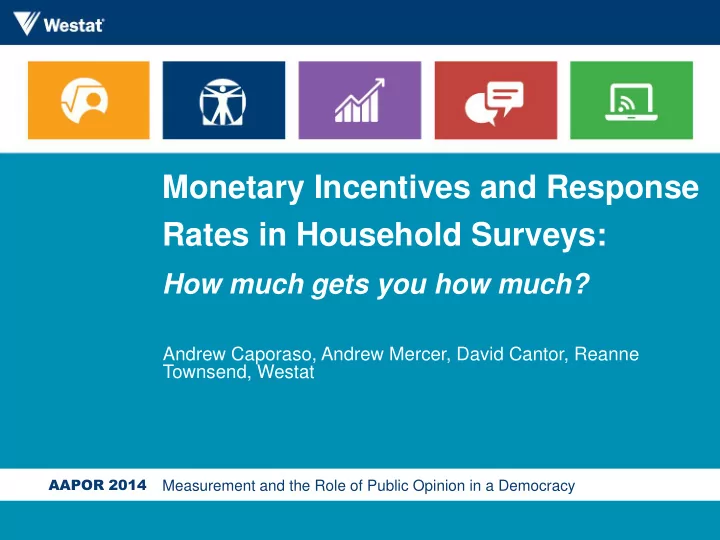

Monetary Incentives and Response Rates in Household Surveys: How much gets you how much? Andrew Caporaso, Andrew Mercer, David Cantor, Reanne Townsend, Westat AAPOR 2014 AAPOR 2014 Measurement and the Role of Public Opinion in a Democracy Measurement and the Role of Public Opinion in a Democracy
Our research questions • What is the expected improvement in response rate per dollar of incentive? – The dose-response relationship • How is this relationship impacted by… – Incentive timing (prepaid or promised)? – Data collection mode? – Burden & sponsorship? • Has the relationship changed over time? – We look at research from the past 2 decades AAPOR 2014 AAPOR 2014 2
Methodology – Meta-analysis • Meta-analysis of experimental* literature on incentive use… – Published 1992 or later – Pertaining to a mail, telephone or in-person survey – Targeted at general population samples – Testing monetary incentives offered at the onset of the survey request (prepaid or promised) *comparison of two or more incentives in the same survey AAPOR 2014 AAPOR 2014 3
Methodology – Data captured • DV: Response rate ; • IV: Incentive amount , converted to $2012 USD, natural log transformation • Incentive timing (Prepaid, promised); • Mode (Mail, Telephone, or In-person); • Survey sponsor (Government/University, or Private); • Survey considered burdensome (Yes, No); – Definition from Singer, et al. (1999). • Year of experiment or year/publication ; AAPOR 2014 AAPOR 2014 4
Meta-analysis – Literature search • After conducting a thorough literature search… – Over 200 reports found on incentive effects • 40 met criteria for meta-analysis – 55 experiments summarized in 40 reports • 178 conditions tested across 55 experiments AAPOR 2014 AAPOR 2014 5
Data Summary I Distribution of experimental conditions by mode of experiment, incentive timing & incentive value details Telephone Mail In-Person (n = 59) (n = 94) (n = 25) Timing Prepaid 17 73 8 Promised 21 2 11 No Incentive 21 19 6 Prepaid Values ($2012) Min $1.38 $1.06 $1.54 25th Percentile $2.50 $2.82 $10.29 Median $2.82 $6.38 $18.44 75th Percentile $6.89 $11.27 $32.53 Max $7.04 $56.94 $56.38 Promised Values ($2012) Min $5.88 $5.54 $1.54 25th Percentile $12.15 $7.14 $28.96 Median $21.46 $8.75 $36.85 75th Percentile $29.27 $10.35 $52.98 Max $50.07 $11.96 $74.65 AAPOR 2014 AAPOR 2014 6
Data Summary II Distribution of experimental conditions by mode of experiment, year, burden, and survey sponsorship Telephone Mail In-Person (n = 59) (n = 94) (n = 25) Year 1987-1991 2 0 4 1992-1996 11 4 3 1997-2001 21 54 3 2002-2006 21 23 6 2007-2011 4 13 9 Burden Low Burden 59 38 3 High Burden 0 56 22 Sponsor Government 25 36 21 University 24 16 4 Private 10 42 0 AAPOR 2014 AAPOR 2014 7
Methodology – Statistical analysis • Hierarchical regression model – Level 1: Conditions – Level 2: Experiments • Weighted by precision – Based on condition sample size AAPOR 2014 AAPOR 2014 8
Regression Model Predicting Response Rate Parameter B S.E. Intercept 0.26 (0.062)* ln($) [prepaid] 0.06 (0.009)* Mail 0.01 (0.056) In-Person 0.37 (0.092)* High Burden -0.27 (0.063)* Gov./Univ. Sponsor - - Year minus 2013 -0.02 (0.004)* ln($) x Promised -0.04 (0.011)* ln($) x Mail 0.03 (0.011)* ln($) x In-Person -0.02 (0.016) ln($) x Burden - - ln($) x Gov./Univ. Sponsor - - ln($) x Year - - ln($) x Mail x Promised -0.05 (0.019)* * p < .05 ln($) x In-Person x Promised 0.03 (0.020) AAPOR 2014 AAPOR 2014 9
Estimated improvement in response rate relative to no incentive by incentive value, timing and mode Conditional average gain in response +/- 95% Confidence Interval AAPOR 2014 AAPOR 2014 10
Estimated improvement in response rate relative to no incentive by incentive value, timing and mode Phone Phone 2012$ Mail prepaid prepaid promised In person $1 +.06 +.04 +.01 +.02 $2 .10 .07 .02 .03 $3 .12 .08 .03 .04 $4 .14 .10 .03 .05 $5 .16 .11 .04 .05 $10 .22 .14 .05 .07 $15 .25 .17 .06 .08 $20 .27 .18 .06 .09 $30 .31 .21 .07 .10 $40 .33 .22 .07 .11 $50 .35 .24 .08 .12 AAPOR 2014 AAPOR 2014 11
Incentive Conclusions • Effects on response rates: • Dependent on mode and incentive timing • Still much variability across studies • Effect of survey characteristics: • Incentive timing matters • Most important in telephone surveys • Least important for in-person surveys • Inconclusive for mail • Findings inconclusive for sponsorship, burden • Effects over time: • No changes observed over time* • *mitigated by declining response rate overall AAPOR 2014 AAPOR 2014 12
Future research • Incentives and costs • Promised mail incentives • Web incentives • Incentives for other populations? – Establishments? – Physicians? – Low income? AAPOR 2014 AAPOR 2014 13
Thank you! • Andrew Mercer • Reanne Townsend • David Cantor • Aaron Maitland, Roger Tourangeau, Mike Brick, Doug Williams, Darby Steiger • Jon Ratner • Everyone in AAPOR who contributed research andrewcaporaso@westat.com AAPOR 2014 AAPOR 2014 14
Recommend
More recommend